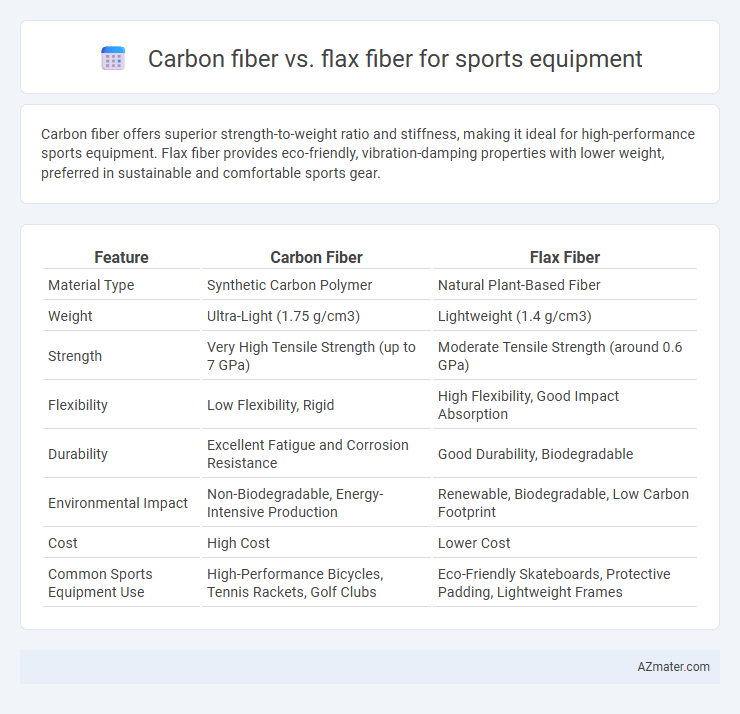Carbon fiber offers superior strength-to-weight ratio and stiffness, making it ideal for high-performance sports equipment. Flax fiber provides eco-friendly, vibration-damping properties with lower weight, preferred in sustainable and comfortable sports gear.
Table of Comparison
| Feature | Carbon Fiber | Flax Fiber |
|---|---|---|
| Material Type | Synthetic Carbon Polymer | Natural Plant-Based Fiber |
| Weight | Ultra-Light (1.75 g/cm3) | Lightweight (1.4 g/cm3) |
| Strength | Very High Tensile Strength (up to 7 GPa) | Moderate Tensile Strength (around 0.6 GPa) |
| Flexibility | Low Flexibility, Rigid | High Flexibility, Good Impact Absorption |
| Durability | Excellent Fatigue and Corrosion Resistance | Good Durability, Biodegradable |
| Environmental Impact | Non-Biodegradable, Energy-Intensive Production | Renewable, Biodegradable, Low Carbon Footprint |
| Cost | High Cost | Lower Cost |
| Common Sports Equipment Use | High-Performance Bicycles, Tennis Rackets, Golf Clubs | Eco-Friendly Skateboards, Protective Padding, Lightweight Frames |
Introduction to Carbon Fiber and Flax Fiber
Carbon fiber consists of thin, strong crystalline filaments of carbon held together by resin, offering exceptional strength-to-weight ratio and stiffness, making it a preferred material for high-performance sports equipment such as tennis rackets and bicycles. Flax fiber, a natural plant-based fiber derived from the flax plant, provides a sustainable alternative with good vibration damping and moderate strength, favored in eco-conscious sports gear manufacturing. Both materials balance performance and weight but differ significantly in sustainability, cost, and impact on the environment in sports equipment applications.
Material Composition and Properties
Carbon fiber consists of tightly woven carbon filaments offering exceptional tensile strength, high stiffness, and low weight, making it ideal for high-performance sports equipment requiring durability and lightweight characteristics. Flax fiber, derived from natural plant fibers, provides moderate strength, good flexibility, and excellent vibration damping, appealing to eco-friendly designs and applications prioritizing sustainability and comfort. The intrinsic differences in material composition result in carbon fiber excelling in stiffness and strength-to-weight ratio, while flax fiber offers biodegradability and impact absorption suited for lower-impact sports gear.
Strength and Durability Comparison
Carbon fiber offers superior strength-to-weight ratio and exceptional durability, making it ideal for high-performance sports equipment that demands maximum stiffness and impact resistance. Flax fiber, while less strong and durable than carbon fiber, provides enhanced biodegradability and vibration damping properties, contributing to comfort and sustainability in mid-range applications. The higher tensile strength and fatigue resistance of carbon fiber ensure longer lifespan and better performance under extreme stress compared to flax fiber composites.
Weight and Performance Efficiency
Carbon fiber offers superior weight-to-strength ratio compared to flax fiber, making it the preferred choice in high-performance sports equipment requiring lightweight durability. Flax fiber, while heavier, provides better vibration damping and eco-friendly attributes but falls short in stiffness and tensile strength crucial for elite athletic performance. The enhanced stiffness and low weight of carbon fiber translate into faster responsiveness and greater energy efficiency in equipment like bicycles and tennis rackets.
Environmental Impact and Sustainability
Carbon fiber, derived from petroleum-based precursors, has a high energy footprint and is challenging to recycle, raising concerns about its environmental impact in sports equipment manufacturing. Flax fiber, a natural and renewable resource, offers significant sustainability advantages due to its lower carbon emissions, biodegradability, and minimal processing requirements. Choosing flax fiber over carbon fiber supports eco-friendly sports gear production by reducing reliance on fossil fuels and improving end-of-life disposal options.
Cost Analysis and Accessibility
Carbon fiber sports equipment offers superior strength-to-weight ratio but comes with significantly higher manufacturing costs and limited accessibility due to complex production processes. Flax fiber provides a more cost-effective and sustainable alternative with easier availability, though it delivers lower performance and durability compared to carbon fiber. Choosing between the two materials requires balancing budget constraints with performance needs, making flax fiber ideal for entry-level or eco-friendly products while carbon fiber suits high-end, professional gear.
Flexibility and Shock Absorption
Carbon fiber offers exceptional stiffness and strength, providing rigid support ideal for high-performance sports equipment, while its limited flexibility can reduce shock absorption. Flax fiber delivers superior flexibility and natural vibration damping, enhancing comfort and impact resistance in sports gear. The choice between carbon fiber and flax fiber depends on striking a balance between maximum rigidity and improved shock absorption tailored to specific athletic needs.
Popular Sports Applications
Carbon fiber is widely used in high-performance sports equipment such as tennis rackets, bicycles, and racing boats due to its exceptional strength-to-weight ratio and stiffness, enhancing speed and control. Flax fiber, favored in eco-friendly and sustainable sports gear like yoga mats, protective helmets, and some bike frames, offers decent durability with added vibration dampening properties. Both fibers play crucial roles in sports applications where carbon fiber dominates in elite performance gear, while flax fiber appeals to environmentally conscious athletes seeking lightweight and natural alternatives.
Athlete Feedback and User Experience
Athlete feedback highlights carbon fiber's superior strength-to-weight ratio and rigidity, offering enhanced performance and durability in sports equipment, while some users report discomfort due to its stiffness. Flax fiber is praised for its natural vibration damping and flexibility, providing a more comfortable feel and better shock absorption that reduces fatigue during extended use. Users often appreciate flax fiber's eco-friendly properties and its ability to blend performance with sustainability, though it may lack carbon fiber's ultimate strength for high-impact applications.
Future Trends in Sports Equipment Materials
Carbon fiber remains the dominant choice for sports equipment due to its exceptional strength-to-weight ratio and durability, but flax fiber is gaining attention for its sustainability and natural vibration-damping properties. Future trends indicate a rise in hybrid composites combining carbon and flax fibers to optimize performance while reducing environmental impact. Innovations in bio-based resins and recyclable materials further drive the development of eco-friendly sports gear without compromising on strength and stiffness.

Infographic: Carbon fiber vs Flax fiber for Sports equipment
 azmater.com
azmater.com